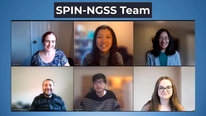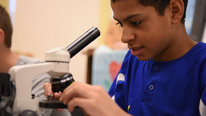RAPID: Aspire: Formative Assessment of Scientific Practices Research Practice...
NSF Awards: 1561751
2019 (see original presentation & discussion)
Grades 9-12
How can we support teachers as they learn to design and enact classroom assessments that provide useful and relevant information about student learning of the NGSS? The Aspire-II project is a partnership between a large school district and university-based researchers that seeks to develop assessments that serve both formative and summative functions. In this video, we describe the origin of our partnership, our early work with teachers to surface their perceptions of NGSS assessment, and the some of the professional learning we have employed to support teacher learning around the NGSS.
Related Content for Toward a System of Three-Dimensional Classroom Assessment
-
 2020Accomplishments and struggles in a 3-way RPP
2020Accomplishments and struggles in a 3-way RPP
Emily Weiss
-
 2015Researcher-Practitioner Partnerships in STEM Education
2015Researcher-Practitioner Partnerships in STEM Education
Philip Bell
-
 2021Student Reasoning Patterns in NGSS Assessments
2021Student Reasoning Patterns in NGSS Assessments
Lei Liu
-
 2021Virtual PD for STEM Teachers—Lessons for a New Landscape
2021Virtual PD for STEM Teachers—Lessons for a New Landscape
Sarah Michaels
-
 2022STEM-Computer Science Project for KY Teachers
2022STEM-Computer Science Project for KY Teachers
Dale Goatley
-
 2015Promoting Quality Talk in High School STEM Classes
2015Promoting Quality Talk in High School STEM Classes
P. Karen Murphy
-
 2018CAFÉCS: Supporting Quality CS Access 4 All Chicago Students
2018CAFÉCS: Supporting Quality CS Access 4 All Chicago Students
Steven McGee
-
 2021Integrating Computer Science with Middle School Science
2021Integrating Computer Science with Middle School Science
Marina Van der Eb

Cristina Heffernan
What sorts of technology tools are you using for the formative assessment?
Erin Furtak
Professor and Associate Dean
Thanks for your question, Cristina - while the majority of the co-designed formative assessments have been paper-and-pencil, teachers in some schools have used PhET simulations, and we are piloting some of our co-designed items in the Illuminate platform this spring.
Jonathan Margolin
Was the problem of practice how teachers can use formative assessment for three dimensional learning? Or was it how to build a common language about formative assessment? In any event, what is the project doing to develop these formative assessments?
Erin Furtak
Professor and Associate Dean
Thanks for your question, Jonathan - our original problem of practice had to do with how we could build common language around and ownership of formative assessment between teachers and students. For the last several years, we have worked to support high school teachers in content-specific professional learning communities in the Formative Assessment Design Cycle, in which teachers iteratively learn about student ideas with the support of learning progressions, design formative assessment tasks, rehearse using those with students, enact the assessments, and then identify next steps for instruction.
Frank Davis
I am very interested in the idea of research practice partnerships, particularly, in school settings. How to cross boundaries between school leaders/ administrators who must deal with issues of accountability usually through summative assessments, teachers who must deal with teaching students at various levels where formative assessments would be most helpful, and researchers who have interests as well as a need to contribute to various research domains of study – including improving various school based practices is a difficult and key question. From your video I can see some of these tensions as you discuss teachers concerns.
I understand some of this work in the beginning stages involves building a common language about formative assessment with the NGSS as a context. Could you give an example of this language that is helping to bridge these boundaries.
I am also wondering how issues of diversity of students’ backgrounds are also being considered in this language about assessments.
Sheila Homburger
Erin Furtak
Professor and Associate Dean
Thanks for your question, Frank - we have done a lot of work to help teachers see formative assessment as something they already do everyday - that is, ask questions and attend to information about what students know and are able to do. From there we have worked to help identify compelling questions relevant to students’ lived experiences that can then be used as compelling phenomena that students want to explain, and which are the launching point for formative assessment activities. We have also done work to develop rubrics and checklists for formative assessment tasks that support students from diverse linguistic backgrounds.
Mac Cannady
Research Group Director
Great video and very helpful explanation of how you approached this work. I really appreciate how you described the origin of the research and practice partnership, specifically that it came from the practice side of the partnership.
Can you offer some insights for other researchers to establish the sorts of relationships or connections that might foster more research and practice partnerships?
Thanks!
Erin Furtak
Professor and Associate Dean
Thanks for your question, Mac - what has been so special about this relationship was that I was invited in by the district, rather than me approaching the district as I had in previous work. I have found that just getting out there in settings where I will interact with curriculum coordinators and teachers has led to this and other productive partnerships - e.g. presenting at state science meetings, observing teacher candidates in the field, and letting people know that I want to partner and learn “with and from” each other.
Meg Bates
Yes, this is a great comment and interesting project! I think it's so important that researchers like us disseminate to practitioners and make a strong effort to understand and collaborate with practitioners around their real issues.
Susan McKenney
Professor
Nice story - thanks for sharing! I wonder if any of the collaboratively developed resources are already available for others to see? I'd be really interested to see some of the assessments (or the rubrics/ checklists for checking them).
Kind regards,
Susan
Erin Furtak
Professor and Associate Dean
Thank you Susan - we are in the process of collecting all of our facilitation guides, checklists, and sample assessments for dissemination. You will be able to access them this summer at https://www.colorado.edu/cadre/.
Susan McKenney
K. Renae Pullen
Elementary Science Specialist
How exciting! Thanks so much for listening to the teachers and engaging the leaders as a part of your challenging work. I would love to learn more about the process teachers take to develop multidimensional tasks.
Coralie Delhaye
Hi Erin,
Not only do I find you work very interesting, but I also loved the narration and visual representations on the video.
Could you please give some examples of how the research team supports teachers in identifying next steps for instruction after enacting the assessments? Are you also working together on identifying next steps to further develop the assessments?
We are very interested in this because our teachers recently started using formative assessment surveys of students' understanding of the goals of discussions using scientific argumentation. We currently identify next steps during reflection discussion sessions in groups of teachers and professional learning leaders.
Thank you so much for sharing about this very interesting project!
Warmly,
Coralie
Erin Furtak
Professor and Associate Dean
I am glad you liked the video, Coralie! We have worked in DBR cycles for several years to figure out “what works” in identifying next steps which, in our experience, has been the hardest for teachers to identify.
one approach we have used is the “piling activity” where teachers have to make at least three stacks of student work capturing different qualities (different ideas, models, explanations, etc.) teachers do this in pairs, and making three or more piles helps them look at nuances in student work beyond right and wrong. Then for each pile, we discuss how to support those students.
more recently we have applied the “Student Work focus session” approach developed by my colleague Derek Briggs, in which facilitators and/or teachers preselect a limited set of student responses, make copies of those (3-5 is usually plenty), and then a PLC examines those samples together with a learning progression. This really helps teachers focus and go deep into student work, and also to identify next steps based on the levels of the learning progression.
Coralie Delhaye
Mia Dubosarsky
Coralie Delhaye
Thanks for sharing about those very interesting processes, Erin!
Perla Myers
Nice video! Thanks so much for sharing about your partnership and how the project came about. There is so much to gain from collaborations between school districts and universities! What are some initial lessons learned from this project
Erin Furtak
Professor and Associate Dean
Thanks for your question, Perla - a key lesson I have learned is about what “mutualism” truly means in a partnership. I connect with my district partners on a weekly phone call, and there is always plenty to discuss and negotiate to keep up to speed with what is happening in the district, and in the research. We ask questions of each other, identify and discuss shared readings, and make sure the project represents “our” needs collectively, not just one side or the other. Communication, trust, and rapport have been just key.
Momo Hayakawa
What grade levels are you working with? Our project aligns to K-2 NGSS - however, we're running into the challenge of most NGSS aligned materials, assessments, etc. are developed for older students. Do you have insight as to why the focus is on older students (3rd grade and beyond)?
Erin Furtak
Professor and Associate Dean
Thanks for watching, Momo - since our partnership began we have completed different smaller projects k-12, but the primary focus of our work has been grades 9-11. It’s been my experience that there are not quite as many materials in high school either - the primary focus of development for many assessments has been middle school (at least as much as we have been able to find).
Heidi Carlone
This is great work, Erin! It's a lovely model of research/practice partnership for those of us just embarking on the work. I appreciate that you're building capacity for sustainability. Excellent representation of the work via this video! Thank you.
Further posting is closed as the event has ended.